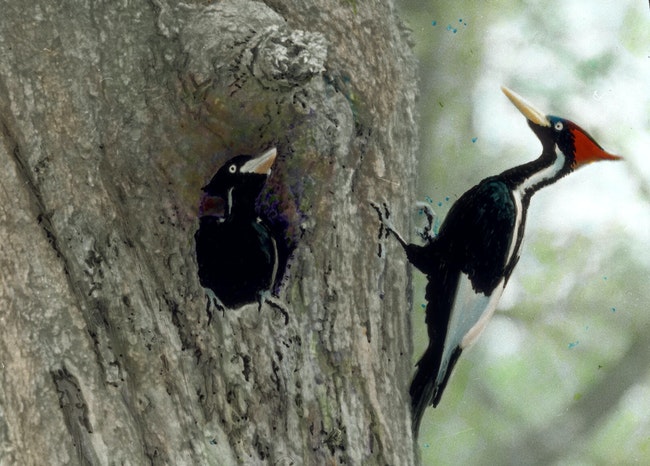
A colorized rendition of a photograph taken by Arthur Allen of an Ivory-billed Woodpecker at a nest in Louisiana’s Singer Tract, 1935. (Cornell Lab of Ornithology)
After almost eight decades without a confirmed sighting in the U. S. the federal government declared the ivory-billed woodpecker “extinct” last September.
The ivory-billed woodpecker was the largest in North America. It may still be. Three widely acclaimed efforts to find living ivory-bills in the early 2000s disappointed the bird world. There had been no widely accepted sightings or hearings in the U.S. or Cuba so far this century. Until, maybe, now.
The last widely trusted evidence of the ivory-bills’ survival in the U.S. came from James Tanner’s field work in a Louisiana forest in the 1940s, but that forest was soon logged to help satiate the hunger for lumber during World War II.
The first color drawing of this bird was done by Mark Catesby in the 1730s. He wrote: “The bills of these Birds are much valued by the Canada Indians, who make coronets of them for their Princes and great warriors, by fixing them round a wreath, with their points outward. The northern Indians having none of these birds in their cold country, purchase them off the southern people at the price of two, and sometimes three buck-skins a bill.”
 Mark Catesby’s original ivory-billed woodpecker drawing.
Mark Catesby’s original ivory-billed woodpecker drawing.
People’s business and ivory-bills are ever at odds. With the spread of farming, most of the old growth forest was cut in the southern states. This woodpecker lost its habitat.
By 1840 this bird’s dependence on old forests was clear. That year Thomas Nuttall published his “Manual of the Ornithology of the United States.” Ivory-bills: “More vagrant, retiring, and independent than the rest of his family, he is never found in the precincts of cultivated tracts; the scene of his dominion is the lonely forest amidst trees of the greatest magnitude.”
A 1933 National Geographic feature on American woodpeckers said of the ivory-billed: “So far as is known, its range was formerly confined to the Southern States… From nearly all this vast domain it has disappeared. We know of a very limited number in Louisiana, and there still are some in Florida.”
There was a Cuban population into the 1980s.
Now a team of field biologists have reported on three years spent in an undisclosed forest tract in Louisiana. Using current technology they have images and sound recordings of ivory-billed woodpeckers, they say. As well there are claims of visual encounters. The field work was sponsored by Project Principalis and the National Aviary in Pittsburgh.
Click here for the announcement of their findings.
Click here for National Aviary’s summary of this species’ history.
Click here to read the full, pre-publication version of the research report, before it has been peer reviewed.
For information about upcoming Salem Audubon programs and activities, see www.salemaudubon.org, or Salem Audubon’s Facebook page.
Harry Fuller is an Oregon birder and natural history author of “Freeway Birding.” He is a member of the Salem Audubon Society. Contact him at [email protected] or atowhee.blog. His “Some Fascinating Things About Birds” column appears regularly in Salem Reporter.
JUST THE FACTS, FOR SALEM – We report on your community with care and depth, fairness and accuracy. Get local news that matters to you. Subscribe to Salem Reporter starting at $5 a month. Click I want to subscribe!









